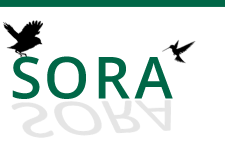Abstract
El Censo Neotropical de Aves Acuáticas (CNAAV) es un proyecto regional a largo plazo que en 2021 cumplió 16 años consecutivos en Venezuela. Se cuantificaron 78 especies (73 en febrero y 55 en julio), 35.662 avistamientos (30.546 en febrero y 5.116 en julio), pertenecientes a 19 familias (18 en febrero y 16 en julio). Durante los conteos del 2021,se registraron 49 especies residentes (47 en febrero y 31 en julio), 22 migratorias (21 en febrero y 16 en julio), y ocho residentes con poblaciones que migran desde o hacia la región neártica (6 en febrero y 6 en julio), para un total de 35.662 avistamientos, 30.546 en febrero y 5.116 en julio. Se realizaron censos en 19 localidades (12 en febrero y 16 en julio), pertenecientes a siete estados y el Distrito Capital (6 en febrero y 7 julio). La localidad con mayor abundancia fue Produsal (Salina Solar Los Olivitos) (Zulia), y la de mayor diversidad fue la Ciénaga de los Olivitos (34 especies), ambas en el estado Zulia. En cuanto a las especies migratorias, la más abundante fue el Playerito Semipalmeado Calidris pusillla y el Playerito Occidental C. mauri. Para las especies residentes, al igual que en años anteriores, las más abundantes fueron la Cotúa Nannopterum brasilianus y el Flamenco Phoenicopterus ruber. Mientras que el Patico Enmascarado Nomonyx dominica se registró por primera vez miebtras que la Garza Enana Ixobrychus exilis, que cuenta con pocos registros de avistamiento, también fue reportada. Participaron un total de 20 censistas voluntarios, siendo el estado Zulia el que presentó mayor número. En esta oportunidad hubo un aumento en el número de localidades y de censistas con respecto al año anterior.
The Neotropical Waterbird Census (NWC) is a longterm project, which in 2021 celebrated 16 consecutive years in Venezuela. During the 2021 surveys, 78 species were quantified (73 in February and 55 in July): 35.662 sightings (30.546 in February and 5.116 in July); belonging to 19 families (18 in February and 16 in July); 49 resident species (47 in February and 31 in July); 22 migratory (21 in February and 16 in July); and eight residents with populations migrating to or from the Nearctic region (six in February and six in July). Surveys were carried out in 19 localities (12 in February and 16 in July), belonging to seven states and the Capital District (six in February and seven in July). The locality with the highest abundance was Produsal (Salina Solar Los Olivitos), while Ciénaga de los Olivitos had the greatest diversity was in (34 species), both located in Zulia state. Regarding the migratory species, the most abundant were the Semipalmated Sandpiper Calidris pusillla and the Western Sandpiper C. mauri. For the resident species, as in previous years, the most abundant were the Neotropic Cormorant Nannopterum brasilianus and the American Flamingo Phoenicopterus ruber. While the Masked Duckling Nomonyx dominica was reported for the first time, and the Least Bittern Ixobrychus exilis, which has few sighting records, was also reported. A total of 20 volunteer census takers participated, with the state of Zulia being the one with the highest number. The number of localities and volunteers reported increased compared to the previous year.
Creative Commons License
Recommended Citation
Sainz-Borgo, Cristina; Angelozzi-Blanco, Gianco; Bernay-Alfonzo, Wilber; Fernández-Ordóñez, Juan Carlos; Luy, Alejandro; Martínez, Margarita; González, Miguel Nieves; Silva, Sabino; Torres, Lermith; and Torres, Miguel Ángel
(2022)
"Censo Neotropical de Aves Acuáticas en Venezuela 2021 / Neotropical Waterbird Census in Venezuela 2021,"
Revista Venezolana de Ornitología: Vol. 12
:
Iss.
1
, Article 2.
Available at:
https://digitalcommons.usf.edu/rvo/vol12/iss1/2

